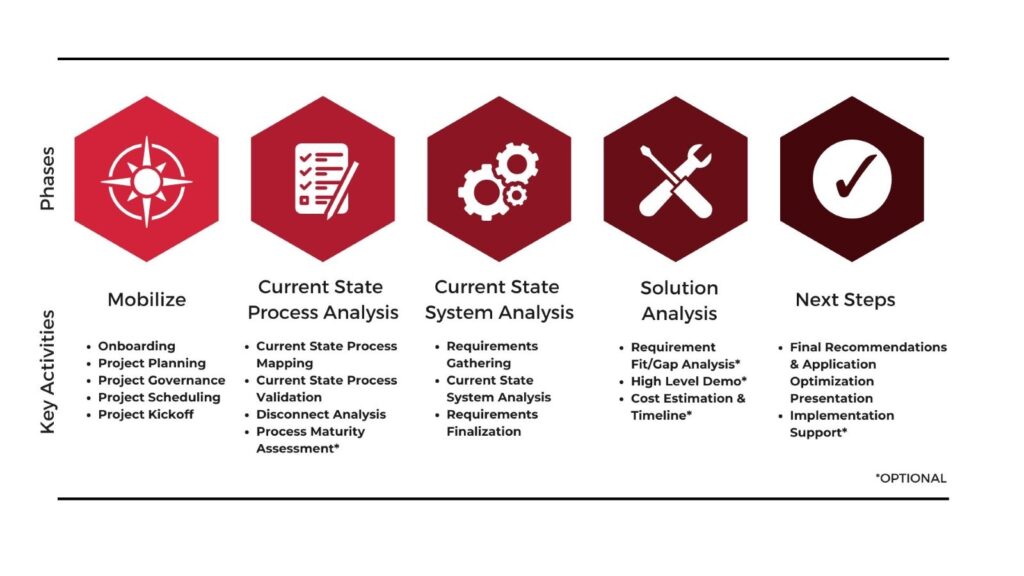
Preparing for Your EBS to Cloud Journey
As your organization navigates the transition from E-Business Suite (EBS) to Cloud, maximizing your on-premise investment is essential for creating opportunities and fostering company success. Challenges may arise on your journey to Oracle Cloud, these hurdles may include customization reviews, outdated application tools, falling behind on major releases, difficult business process alignment, or even change management.
Luckily, Elire’s methodology for business process definition, customization identification, and Cloud Readiness Assessment can help you overcome any challenges you face on the road to Oracle Cloud.
Throughout your EBS to Cloud journey, you will prepare your EBS environment for the switch by optimizing current on-premise applications, building your Oracle Cloud roadmap, and completing Elire’s expert Cloud Readiness Assessment. Whether your organization is EBS pre-12.2 or currently running up to date EBS 12.2 functionality, Elire can help on your journey.
Prepping Your EBS Environment
EBS pre-12.2
Evaluating 12.2 readiness begins with reviewing business processes, customizations, change impact, and business goals. Elire’s Application Roadmap maps your organization’s ideal future state, application options, and unique business needs. Setting project scope and making the move to modern EBS 12.2 sets the groundwork for customization removal and any necessary data conversions your organization may undergo.
EBS 12.2 Optimization
For organizations already operating on EBS 12.2, it’s important to leverage the most up to date application tools, user interface, and application enhancements as this allows for more efficient upgrades and decustomizations. Elire aims to optimize EBS environments by removing or reengineering customizations that sit outside the application’s functionality, are too demanding, or fail to integrate with the application.
Optimization begins with application of all the “bells and whistles”, including Enterprise Command Centers, G-Invoicing for US Federal Program Agencies, EBS Mobile Release 9, HRMS Release Update Pack, EBS Person Data Removal Tool, and EBS Cloud Manager for Oracle Cloud Infrastructure. Extending EBS applications and utilities creates a more modern user experience for all involved. Learn more about EBS optimization with Elire’s EBS 12.2 Application Roadmap below.

Building Your Oracle Cloud Roadmap
Examining Strategic Drivers
Embarking on the journey to Oracle Cloud requires a solid roadmap, and it all starts with defining your organizational Cloud strategy. This foundational step involves several key considerations. Firstly, benchmarking or scoring your current state of Cloud readiness is essential to understand where your organization stands in its Cloud adoption journey.
Determining your cloud software strategy is crucial – will you prioritize a single vendor approach or opt for a mix of multiple point solutions? Lastly, deciding on your implementation approach, whether it’s gradual co-existence with legacy systems or a bold full-scale implementation, sets the tone for your Cloud migration journey. By addressing these fundamental aspects, you pave the way for a successful and strategic move to Oracle Cloud.
As you chart a course with your Cloud Roadmap, these actions help in fine-tuning various aspects of your business operations:
- Transitioning to a SaaS Treasury Management System (TMS), like Kyriba, empowers your treasury operations, ditching cumbersome spreadsheets for state-of-the-art treasury solutions in the cloud
- Rolling out Accounts Payable (AP) Automation smooths out Procure-to-Pay processes, cuts down on manual errors, boosts process flexibility and visibility across your AP landscape
- Diving into a Cloud Pilot or Proof of Concept (POC) lets you test waters of Oracle Cloud, tackling urgent pain points and targeted process improvements without long-term commitments
These targeted actions pave the way for a more seamless transition to Oracle Cloud and drive transformative results across your organization.
Determining Decision Criteria
Determining your Cloud Transformation Decision Criteria is essential before starting on your Cloud journey. This critical step ensures that all stakeholders have a common understanding and unified support for your transformation. Key considerations in establishing these criteria include:
- Defining your Cloud software strategy: Choosing between being “Oracle First” or exploring multiple point solutions tailored to your organization’s needs
- Determining your implementation approach: Deciding whether to pursue a gradual co-existence with existing systems or opt for a comprehensive approach
- Strategizing legacy system decommissioning: Planning how legacy systems will be phased out and the extent of reliance on them in the new Cloud environment
- Identifying pain points and transformation scope: Assessing whether your focus is on addressing specific pain points or initiating a holistic application transformation
- Considering internal and external factors: Evaluating competing initiatives, accounting factors, compliance requirements, and external market influences that may impact your journey to Oracle Cloud
By establishing these guiding principles, organizations lay a solid foundation for their cloud endeavors, ensuring alignment, clarity, and efficiency throughout the transformation process.
Defining Requirements
Defining your Cloud requirements means finding a healthy balance – not too vague and not too detailed – of project priorities. Key priorities may include the number of legal entities required, data volume, historical conversions, and integration points. Additionally, you may consider POCs or solutions beyond the Cloud for unique business needs that don’t fit standard Cloud structures. Review new Cloud capabilities like Autocomplete and Redwood Visual Builder to address customizations effectively and create a tailored Cloud ecosystem.
Cloud Readiness Assessment
Preparing your Cloud project involves three key steps, Stakeholder Alignment, Project Mobilization, and User adoption:
- Stakeholder Alignment helps to identify key supporters and establish communication plans
- Project Mobilization involves setting up your steering committee, designated leads, and project timeline
- User Adoption includes creating a change management plan, defining support roles, and planning for training
These actions ensure a solid foundation for Cloud success, and foster alignment, communication, and user engagement.
Elire’s Cloud Readiness Assessment analyzes 12 key components of migrating from EBS to Oracle Cloud, let’s dive into each one!

Motivation
There are various factors that are critical for organizational goal alignment on the journey to Cloud. Key maturity criteria for motivation readiness includes clarity of business objectives, prioritization of drivers, stakeholder buy-in, and alignment of guiding principles.
Governance
Establishing a strong governance framework is a very important step for Cloud success. Maturity criteria for governance readiness includes creating a governance framework, fostering stakeholder engagement, changing control processes, and understanding performance metrics and reporting.
Resource Planning
A detailed resource strategy cultivates more skilled and agile workforces on Cloud migration projects. Maturity criteria includes correct training and certification, identifying key roles, creating a resource allocation plan, and performing a skill gap analysis.
Customizations
Maximizing application alignment and minimizing customization complexity is always the goal when it comes to customization readiness. Customization maturity criteria includes thorough customization inventory, customization alignment, developing a customization reduction strategy, and customization documentation.
Business Process Mapping
Business Process Mapping and Gap Analysis help identify and address critical project gaps for a more seamless Cloud migration. Maturity criteria includes Business Process Mapping, comprehensive Gap Analysis, creating an action plan for addressing gaps, and alignment of business objectives.
Change Management
Adapt to project changes and accelerate application adoption with comprehensive Change Management. Maturity criteria includes a new Change Management strategy, Change Impact Assessment, new Change Management resources, and integration of organizational culture.
Deployment Strategy
Tailor your migration approach for maximum impact with a well-developed deployment strategy. Maturity criteria includes deployment approach selection, understanding transformational vs Lift & Shift strategies, setting project timeline and milestones, and identifying your consulting partner’s role.
Data Conversion
Data conversions can make or break a project, so preparing for successful data conversion is essential. Maturity criteria includes data mapping, data quality, conversion tools, and new data archiving strategies.
Reporting
Transform your data into actionable insights with Cloud reporting readiness. Maturity criteria includes full reporting inventory, reporting alignment, reporting rationalization strategies, and reporting development and customization.
Infrastructure
Optimize integrations and extensions for a more robust Cloud ecosystem. Infrastructure maturity criteria includes integration inventory, integration architecture, integration tools and technology, and a comprehensive integration test plan.
Security
Ensuring compliance and creating strong Cloud security is crucial for Cloud readiness. Maturity criteria includes new security strategies, security controls and processes, security testing and validation, and industry-specific Cloud requirements.
What’s Next?
No matter where you stand on your journey from on-premise to Cloud, Elire offers tailored solutions to drive your transformation. Elire specializes in on-premise Optimization, conducting thorough reviews of your EBS application. Through this process, we identify opportunities for improvement, and recommend reconfiguration strategies. Additionally, Elire prioritizes customization removals and potential reengineering for greater system agility and adaptability.
Elire offers expert evaluations of EBS versus Cloud options and what’s the best fit for your organization. Our industry experts offer free Cloud Readiness Assessments that give real, tangible, and actionable next steps on your Cloud journey. To learn more about receiving an Elire Cloud Readiness Assessment, reach out to [email protected]. To stay up to date on all things Oracle Cloud, subscribe to Elire’s Monthly Cloud Newsletter or follow us on LinkedIn and Twitter.
Subject Matter Expert
-

Arjun Krishnaprasad
Arjun Krishnaprasad serves as Elire’s Strategic Advisory Services Practice lead. With over 14 years of professional experience, his blend of functional and technical expertise qualifies him to solve complex business process challenges and lead his team and clients to successfully achieve their shared goals.
Author
-

Ms. Hutchcraft serves as Elire’s Marketing Specialist, working to develop and optimize marketing brand assets. Jordan collaborates with the Elire Team to produce blog and social media content, strategize for social media expansion, and maintain Elire’s internal and external branding.
View all posts
